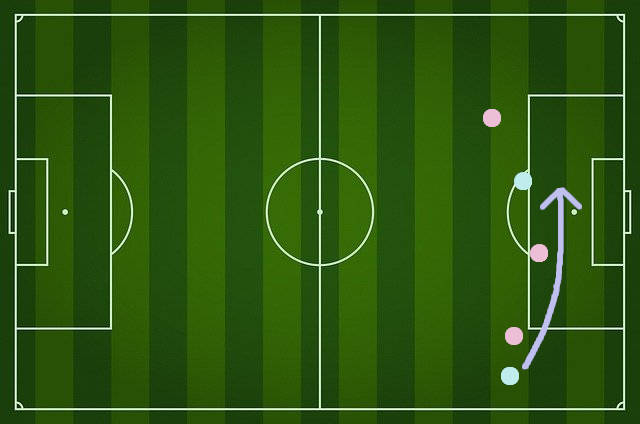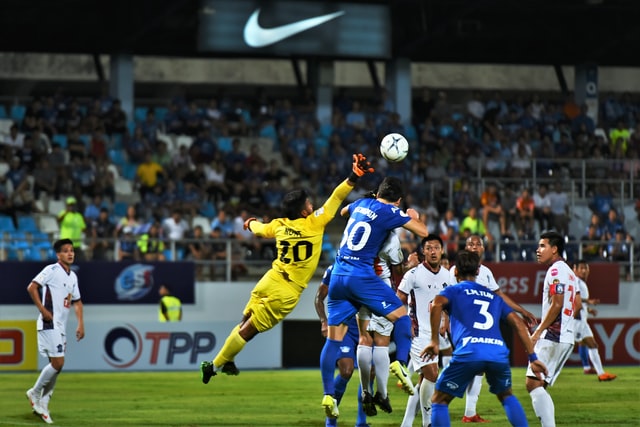Crossing the ball in soccer has become one of the major ways to create goal scoring opportunities. Crossing is used by almost all professional teams, and it is sometimes all of what a team does during the whole 90 minutes of a soccer game.
Simply put, crosses are at the heart of every professional game, and it is essential as a soccer fan to know at least what a cross is, which is exactly what this article is for.
What is a soccer cross?
A cross in soccer is a pass that aims to send the ball from one of the wide areas of the field towards somewhere inside or near the penalty area of the opponent. Crosses are especially effective against defensive teams and they can provide direct goal scoring opportunities to the team executing it.
So a cross is just another pass, but it is one that aims to create a direct threat against the opponent team. Here is what a cross looks like:

Before we move on, if you don’t know what the penalty area is, it is the large box area that is marked in front of each of the teams’ nets. You can learn more about the rules that this area imposes on goalkeepers by clicking here.
Now back to crosses in soccer…
Why is it called a cross?
Many soccer passes’ names are usually based on the direction of the ball and its movement when the pass is done, and the cross is one of them.
When you do a cross, you usually kick the ball and make it move across the field from a wide area towards the center of the field.
So it is as if the ball is cutting through / crossing the field, and hence the name.
How important/effective is a cross in soccer?
At first glance, one might think that a cross in soccer is just another pass/tactic that one team tries every now and then to reach the opponent’s goal.
However, when you learn that sometimes it’s literally all of what a team does, you start to think that there is more to a cross than just some random thing a player tries.
There are managers that build their whole team around crosses. They use formations, tactics, and certain players to make sure that the team gets the most out of their crosses.
For example, if a soccer team has a striker that is very good with headers, then it makes so much sense that their team tries to cross the ball in the air towards the striker very often.
Players like Cristiano Ronaldo, Robert Lewandowski, Luuk De Jong (yes, you read that right), and others are examples of players that you always want to send crosses towards.
So in simple words, if a manager has a player that is extremely effective with header goals and crosses, it makes sense that you build the team around these players and constantly keep feeding them crosses so that they convert some of them to goals.
When are crosses mostly effective?
Crosses in soccer are very effective against defensive teams. Throughout the years, the defensive aspect of the game has been getting better and better.
Big soccer teams have realized how important defense is, and they kept pushing their defensive players to the limit to the point that it became much harder to score goals by just penetrating the defense.
Even the best dribblers these days can sometimes find it hard to penetrate a well structured defense.
With that in mind, relying on wingers and crosses has become more popular over the years. If a team can’t penetrate their opponent from the middle of the field, then their next option might be to try to attack from the wide areas and then cross the ball towards the goal.
How to make the most out of a cross?
The chance of scoring a goal from a cross is already relatively low. So teams usually need to have a plan when crossing.
Instead of just carelessly crossing the ball towards the penalty area of the opponent and hoping that a teammate is in the right place at the right time, teams usually rely on strategy.
The most important thing when it comes to crossing is the target. Usually, the wingers or the full back crossing the ball aim towards one of their teammates instead of just blindly kicking the ball.
They look for one of their teammates who’s running towards the penalty area of the opponent, and then they cross the ball in front of them to put them in a position where they can score by only touching the ball once (either kicking it or heading it)
That might sound easy on paper, but it is actually difficult to execute. The player crossing the ball will probably already be running at a very high speed, and they will have to keep track of all players near the penalty area so that they can pick the best spot to kick the ball towards.
They have to make the decision in split seconds and they have to be super accurate. That’s one of the things that make wingers extremely important in soccer.
An effective winger can cause a lot of trouble to their opponent, especially if they are coupled with an excellent striker.
The striker, or whoever is in position to convert the cross into a goal also needs to be aware of their surroundings, and they need to move into an open area where they know they can easily receive the ball from whoever is crossing it.
With that said, having chemistry between the players who usually cross the ball and the players who usually receive the cross is extremely important.
This type of chemistry is usually built on the training field where the players practice a lot of possible scenarios and they make plans on how to convert the crosses into goals.
Managers are also involved. The managers usually analyze the defense of their opponent, and then they might require their team to practice crosses that can be effective against the type of defense their opponent is known for.
To sum this whole section up, an effective cross is one that is aimed towards the player that is in the best position to score.
So in order to make the crosses more effective, the player crossing the ball needs to aim towards the best positioned player to score, and on the other hand players need to position themselves properly on the receiving end to give the crosser more options.
That concludes this article. If you still want to read more, then here are some articles that you might find interesting:

